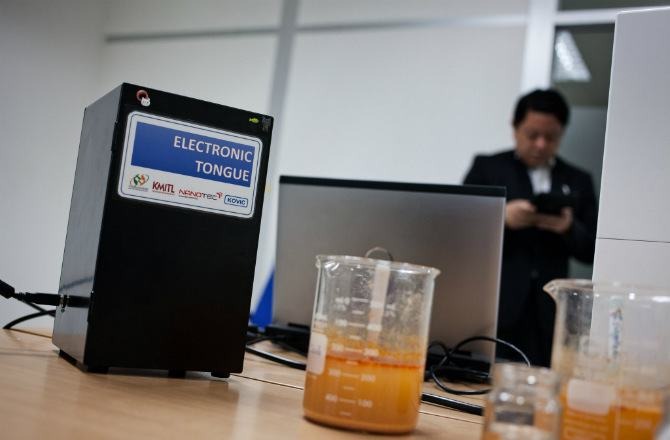2014 In Review: Best Food And Drink Inventions That Prove The Future Is Here
The future of how we eat and drink is changing. After all, to satiate world hunger, we must increase our food production by 70 percent through the next four decades, so we have to keep up with demands. Increasingly, we rely on artificial intelligence technology like the electronic tongue, which can taste the quality of the food before you do, or 3D printers that create unique new foods at the push of a button. At some point you may not even have to eat food anymore, if the guy who invented Soylent, a beige milkshake with all the nutrients you need for one day, gets his way.
The Daily Meal has rounded up some of the coolest and most useful innovations in the food technology sphere, some of which you can buy right now, and others of which are still being developed in labs.
Levitating Cocktails: "A British scientist has invented a machine called the Levitron, which is capable of creating floating, glassless cocktails that you can sip on mid-air. The Levitron uses ultrasonic sound waves to create a small levitating field that suspends tiny drops of alcohol, which drinkers can imbibe on while the droplets float around in front of you."
IBM's Watson Has Turned Chef: Watson is now a master chef after "learning" thousands of recipes from Bon Appétit, and creating endless unique recipes via its new Chef Watson smartphone app. Chef Watson asks you for ingredients you would like to use, the type of dish you would like to make, and the styles you would like to try. Then it will pull up a list of 100 recipes for you, listed in order from classic to experimental with step-by-step instructions."
A Drinkable Book: An innovative device from the nonprofit organization Water is Life, that looks (and even reads) like a regular book that details the importance of clean water. But this book also acts as a water filtration system, purifying the water in many places like undeveloped countries in Asia and Africa, where the water can be toxic."
Color-Changing and Glow in the Dark Ice Cream: These are two separate inventions, but they both take ice cream way beyond cookies and cream. Scientist Michael Linares has created an ice cream he called Xamaleón, which changes in color from lavender to magenta, when you lick it. That's not the only bright idea in ice cream. British food inventor Charlie Henry has now invented the world's first glow in the dark ice cream, which is made with synthetically-engineered jellyfish luminescence."
Soylent Food Alternative: This Soylent is not made from people; it's a beige-colored, milkshake-like food substitute that supposedly contains all of the vitamins, nutrients, and minerals that any human needs to survive... Inventor Rob Rhinehart, over the course of years, has tinkered with the ingredients, and now lives almost entirely off of the food substitute.
Electronic Tongue: Researchers are developing a device that can electronically "taste" or scan food and water for bacterial contamination and toxicity. The electronic tongue works in much the same way as a human or animal tongue, with tiny sensors that detect substances in a sample and send signals to a computer for processing just as taste buds sense and transmit flavor messages to the brain.
3d-Printed Food: The idea of 3D printers has been kicking around for quite a while, but finally, 3D-printed food is being close to being a commercial reality. Put in the necessary ingredients and out pops a meal, made in whatever form or shape you want. One of the most innovative 3D-printed food ideas is softer food for the elderly: "The Smoothfood concept uses new 3-D printer technology called seneoPro that prints out food with the shape and flavor of regular food, but is soft and can be swallowed without chewing."
Test Tube Food: Whether it's a lab-created burger made entirely from stem cells, that "grow" to become meat, or synbio-created saffron and vanilla, "using the actual genetics to re-create the plant within a laboratory setting," scientists creating food literally from scratch in a laboratory environment could be the answer to our worldwide food crisis.
Robots That Can Test Food Authenticity: The Thai Delicious Committee, a government agency created for this task, eventually came up with "an intelligent robot that measures smell and taste in food ingredients through sensor technology in order to measure taste like a food critic.
Food That Exercises Your Body for You Researchers are working with a molecule that activates AMP-activated protein kinase (AMPK) — "a central energy sensor and regulator of energy homeostasis" — that helps facilitate the conversion of muscle glucose and fat into energy... Specifically, the researchers are in the process of examining how potential activators of AMPK which will provide "desirable therapeutic effects" in patients with metabolic disorders like Type-2 diabetes or in those unable to exercise due to old age or disability.
For the latest happenings in the food and drink world, visit our Food News page.
